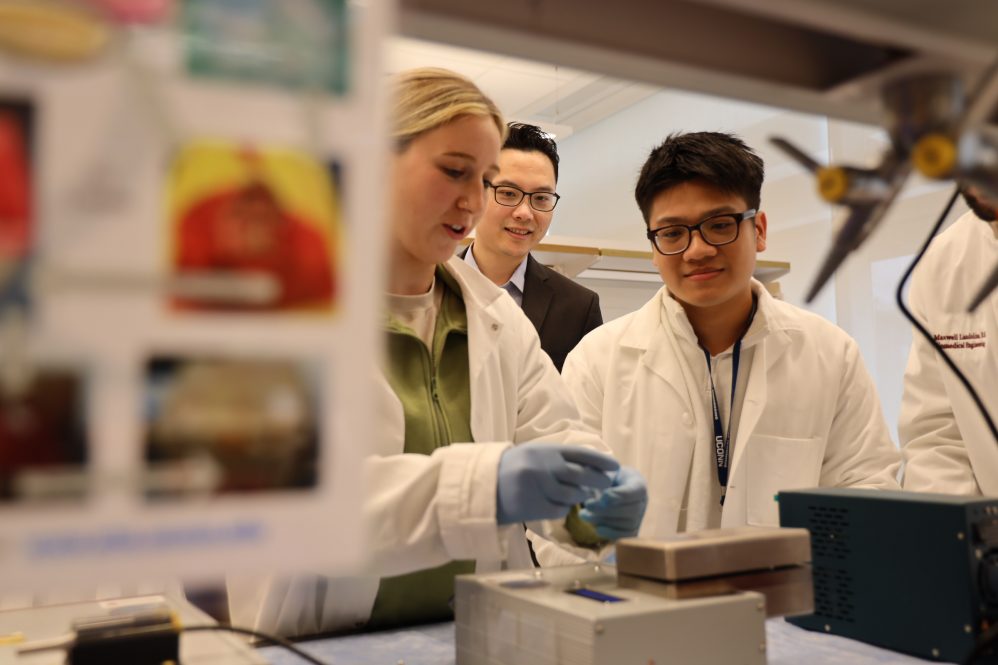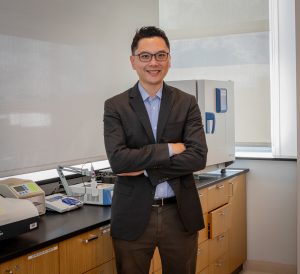UConn researcher focuses on effective biomedicine delivery methods designed for therapeutic and regenerative treatments for people with arthritis, cancer, tumors and neurological diseases

Graduate students Madelyn Pickett and Nguyen Bao Toan Dang operate a sonication device to produce Janus base naoparticles, under the direction of Yupeng Chen (background, center). [Photo by Christopher LaRosa]
An accomplished bioengineering researcher at UConn's College of Engineering (CoE) has received a $1.5 million National Institute of Health grant for his pioneering work in the field of computation-aided molecular design of DNA-inspired Janus Base Nanopieces (JBNps). These are a family of novel biomaterials that mimic DNA and are used in therapeutic and regenerative treatments for people with arthritis, cancer, and neurological diseases.
"JBNps have a distinct advantage for delivery into 'hard-to-penetrate' tissues such as articular cartilage, solid tumors, kidneys and the central nervous system," says Biomedical Engineering Associate Professor Yupeng Chen. "The impact in treatments will be significant."
Chen is the principal investigator and grant recipient, and is studying the impact of manipulating Messenger RNA (mRNA), a molecule that carries the genetic instructions from DNA in the cell nucleus to the ribosomes in the cytoplasm, where those instructions are used to build proteins.
Essentially, Chen explains, mRNA acts like a "message carrier" to tell the cell which proteins to make.
"We will develop a novel delivery technology by manipulating the bio-interface properties of the DNA-inspired Janus Base Nanopieces," Chen says. "JBNps are slimmer than conventional spherical particles, allowing for enhanced infiltration into tissue matrices and barriers."
Messenger RNA, Chen adds, is the key ingredient in COVID-19 vaccines and anti-inflammatory drugs and offers the potential for myriad other applications. But there are numerous obstacles to overcome, he states. Unlike many chemical molecules or antibody proteins, mRNAs need to be delivered into cell cytoplasm to be functional. Various types of materials have been developed for successful intracellular delivery of small RNAs, but it is still a major challenge to achieve effective delivery of mRNAs at both cellular and systemic levels.

Chen cites the study of arthritis as an example. Infiltrating articular cartilage, he says, poses a significant delivery challenge because its matrix has minuscule pore sizes. As a result, no disease-modifying drug exists to treat this condition. JBNps, he explains are smaller and more effectively shaped than the formulations currently being used. They are manufactured through the non-covalent assembly of Janus Bases, allowing researchers to control their formulations and properties by simply mixing different types of Janus Bases.
"For instance, we can use sidechain-modified Janus Bases for endosomal escape, zwitterion-modified ones for improved biodistribution, and unmodified Janus Bases as the basic building blocks for mRNA loading," Chen says. "Additionally, focusing on molecule-linked Janus bases can be used for tissue targeting. In this way, JBNps can be easily tailored for a variety of purposes. We expect to develop sidechain-modified JBNps for the most effective mRNA delivery to treat cartilage diseases such as arthritis."
Last year, Chen and a student team received international notoriety when NASA astronauts aboard the International Space Station (ISS) conducted an inflight, microgravity proof-of-concept study involving the fabrication of JBNps. During their experimentation, the astronauts communicated directly with Chen and some of his students via Axiom Space and Eascra Biotech as implementation and industry partners at their lab on the UConn campus in Storrs, Connecticut.
During the course of this four-year grant, Chen will be working with Dr. Ying Li from the University of Wisconsin, an expert in multiscale computational modeling and machine learning; and Dr. Harvey Lodish from MIT, who will provide expertise in cell and RNA biology and therapeutic development. Their proposal, he adds, is built on successful preliminary results and recent publication in high-impact journals such as in PNAS, Science Advances, Angewandte Chemie, ACS Nano, Advanced Functional Materials, Biomaterials, Computational Mechanics, and others.






